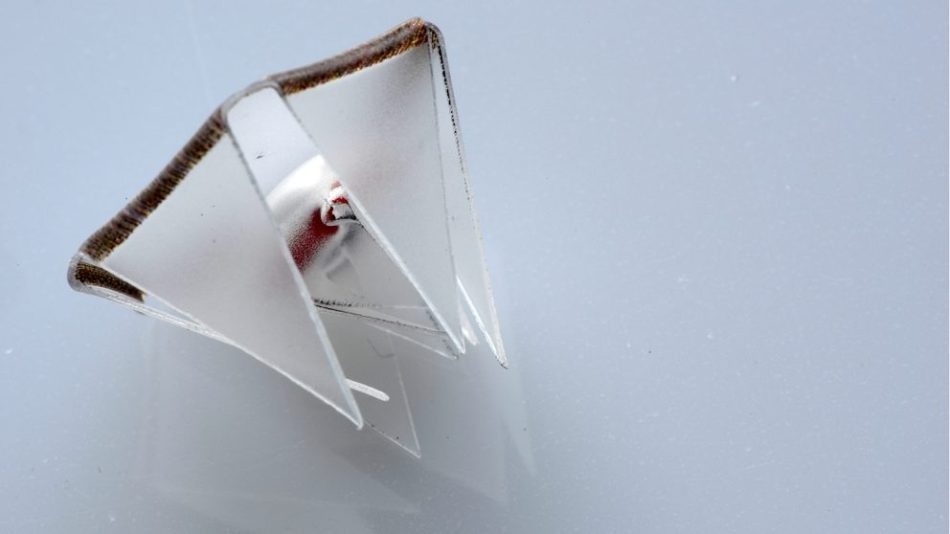Mar 6 2017
 Credit: North Carolina State University
Credit: North Carolina State University
Researchers from North Carolina State University have discovered a new method to remotely control the process employed by a two-dimensional (2D) sheet to fold itself into a three-dimensional (3D) structure. The team came up with this discovery by drawing inspirations from origami.
A longstanding challenge in the field has been finding a way to control the sequence in which a 2-D sheet will fold itself into a 3-D object. And as anyone who has done origami – or folded their laundry – can tell you, the order in which you make the folds can be extremely important.
Michael Dickey, Professor, NC State
“The sequence of folding is important in life as well as in technology,” says co-corresponding author Jan Genzer, the S. Frank and Doris Culberson Distinguished Professor of Chemical and Biomolecular Engineering at NC State. “On small length scales, sequential folding via molecular machinery enables DNA to pack efficiently into chromosomes and assists proteins to adopt a functional conformation. On large length scales, sequential folding via motors helps solar panels in satellites and space shuttles unfold in space. The advance of the current work is to induce materials to fold sequentially using only light.”
The researchers have specifically developed a technique for designing and fabricating 2D materials capable of being remotely controlled in order to activate any of the available folds to take place in any order.
Dickey and Genzer are considered to be early leaders in the field of self-folding 3D structures. An outline of a technique in which a pre-stressed plastic sheet was made to pass through a standard inkjet printer in order to print bold black lines on the material was presented by the researchers in their landmark 2011 paper. This was followed by cutting the material into a specifically desired pattern and the placing the material under an infrared light, for example, a heat lamp.
When compared to the rest of the material, increased energy was absorbed by the printed lines, causing the plastic to contract, developing a hinge that folded the sheets into 3D shapes. The team succeeded in changing how quickly and how far each hinge folds by varying the width of the hinges, or printed lines.
This technique is similar to the commercial printing techniques, which include inkjet printing, roll-to-roll printing, and screen printing, that are high-throughput and cost-effective despite being inherently 2D.
The same technique is used by the new advance, which also takes advantage of the aspect that varied colors of ink absorb a wide range of colors, or wavelengths, of light.
By printing the hinges in different colors, we can control the order of the folds by altering the wavelengths of light that shines on the 2-D sheet.
Jan Genzer, Professor, NC State
For instance, if one particular hinge is printed in yellow and another hinge is printed in blue, the researchers will be able to expose the yellow hinge to blue light, causing it to fold. The blue hinge will not fold as blue ink does not absorb blue light. By exposing the sheet to red light, the researchers will be able to fold the blue hinge.
Additionally, the researchers manipulated the colors of ink and were able to make the hinges fold in a sequential manner when exposed to a single wavelength of light. This is possible because of the fact that a few colors are capable of absorbing a given wavelength of light in a more efficient manner when compared to other colors.
This is a proof-of-concept paper, but it opens the door to a range of potential applications using a simple and inexpensive process. Ultimately, people are interested in self-assembling structures for multiple reasons, from shipping things in a flat package and having them assemble on site to having devices self-assemble in ‘clean’ environments for medical or electronic applications.
Michael Dickey, Professor, NC State
The AAAS journal Science Advances has published the paper, “Sequential Self-folding of Polymer Sheets.” Ying Liu, postdoctoral researcher at NC State, is the key author of the paper. Brandi Shaw, who took part in the research while an undergraduate at NC State, co-authored the paper. The research received support from EFRI program through the National Science Foundation, under grant number 1240438.